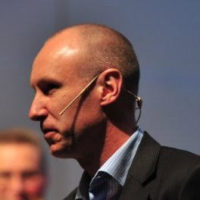As I sit down to write, I’m halfway through my personal retreat time at Chautauqua in western New York, an incredible center for learning, the arts, spirituality, and beauty for all ages. Reflecting on my first week, the theme for the morning lecture series in the 4,400-seat amphitheater was “The Nature of Fear.” While all of the lectures were stimulating, informative, and illuminating, there was one topic that was actually never directly addressed on the main stage: fear itself.
The speakers, nationally or internationally recognized experts in their particular fields, talked all around the subject of fear. They spoke of terrorism, police brutality, racial tensions and violence, global warming, instability in governments, and volatile and unpredictable leaders. They quoted statistics, showed violent video footage, and told stories of horrific happenings. All in all, it was a fairly unsettling week. However, not one speaker looked us directly in the eye, and said, “Let’s talk about fear.”
And so it is in our society today. There is good reason for worry and concern with all that is happening. And we all face challenges from time to time in our personal and professional lives. We tell stories about what is happening, yet we rarely talk about how we’re feeling inside. Or we make jokes in an effort to deflect our fear and discomfort. In our culture, we don’t often openly acknowledge the fears that keep us awake at night. Perhaps it feels too vulnerable. Or maybe we just don’t want to think about it, so we don’t talk about it. In the meantime, the fear keeps eating away at us deep inside. It saps us of energy and focus. In the subconscious mind, fear is increasingly in control.
However, if we are willing to walk toward the fear instead of running away, we begin taking our power back. As soon as we look fear in the eye and ask it what it needs for us to know, something shifts. OK, I admit that in the moment that we first look fear in the eye, it might take every bit of strength and conviction we have to not run away. Yet if we can stay with it, even just for a few moments, courage starts to show up.
Courage is not the absence of fear – it’s the willingness to be with it. As courage rises within us, panic begins to transform into determination. The knot in the stomach turns from heavy stone into fire in the belly. Fear’s grip begins to loosen and the truth in the core of our being becomes our pillar of strength.
Fear is a fact of life. Our willingness to be present with it determines whether fear is in charge, or we are. So how can we be present with fear and transform it into something that can serve us?
Here are five steps that can help you get started.
Step 1 – Let yourself feel whatever you feel. Don’t try to protect yourself from the fear or pretend like it isn’t there. Just acknowledge that you’re afraid. It’s OK. It’s part of life. You don’t have to like it. Just be willing to feel it. And notice where the fear lives in your body – where it has grabbed hold of you physically.
Step 2 – Name the fear. Acknowledge what you are afraid of. Naming the fear can already begin to ease the threat. This is because the part of you that is afraid now knows that you are paying attention, and that you are willing to acknowledge what is going on inside of you.
Step 3 – Breathe into the bottom of your body. If you have trouble breathing deeply, bend over as if you are going to touch your toes, and then breathe. Your breath will automatically go deep into the bottom of your body and re-connect you with your life-force energy and a sense of grounding.
Step 4 – As you continue breathing deeply into the bottom of your body, breathe also into the place in your body where the fear lives. Keep breathing into the fear in your body until it starts to soften. It may take a little time. It’s OK. Keep breathing into the fear.
Step 5 – As the fear begins to soften, ask it what it wants you to know. Don’t worry about how to do that – just do it. Trust that some part of you knows how to listen to the fear. The fear has a message for you – it is trying to get your attention. It wants to know that you are taking what’s happening seriously and are going to do something about it. As you listen to the fear, keep breathing. Be curious and ask the fear questions. Have a dialogue with the fear, and notice what is happening inside of you. Chances are, something inside of you is getting stronger. As you let the fear talk to you, you learn more about it, and you begin to find your way through it.
At the most fundamental level, fear is usually fear of loss. We are afraid that we will lose something or someone that is important to us. As you continue to breathe into the fear and listen to it, be gentle and compassionate with yourself. And be honest. What are you afraid of losing?
Accept whatever comes up. And if it feels like there is still more underneath, then keep breathing, open your heart, and drop down deeper. Don’t try to fix it or make it all OK. Just get used to being with it.
Sometimes, the fear eases fairly quickly. However, initially it may also become even more intense. Acknowledging feelings that have been held back for a long time can open the floodgates of emotions. Again, it’s OK. Keep breathing into the emotions.
If being with the fear and emotions feels like too much to handle on your own, ask someone whom you trust to sit with you for a while. If you want to talk with them about what you are feeling, then talk. And if you want them to be quiet and just listen – to just be with you – tell them that. Let them know what you need. Sometimes strong presence and tender silence is much more healing and supportive than words.
We can’t get rid of fear, but we can transform it. We transform it by engaging with it, listening to it, feeling it, getting to know it. As we get more comfortable being present with the fear, it can show us the way towards courage and acceptance, and to our authentic power and strength.
~ ~ ~
If you enjoyed this blog post and found it helpful or inspiring, please share it with your friends on social media by clicking on the icons below. You are also welcome to make a comment below.
You may subscribe to our free weekly newsletter by clicking here.
Related Blog Posts:
- Jonathan Sacks on Facing the Future Without Fear
- Engage the Unknown and the Fear Transforms
- Fear’s Worst Enemy





































